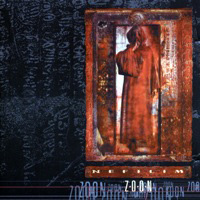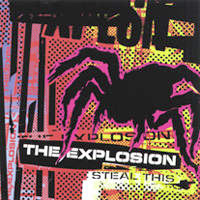 Nefilim
Nefilim
Zoon (Metal Blade)
by Scott Hefflon
The rumor that late ’80s Goth rock kings, Fields of the Nephilim, have returned is partially true, as is the rumor that the new band, simply called Nefilim, is industrial. Either it’s the best of both worlds, or you’ve got half an album to love and half an album to loathe. The opening sound collage of Zoon, “Still Life,” builds a hellish atmosphere slowly – screams in the billowing fog, guitar chords sounding and fading like a distant lighthouse, the increasing, repeated rhythm finally gels into one unmistakable sense of coming, and the chant is now discernible; it’s chanting, “Lies!” over and over again. A crossbreeding of Slayer’s harmonies and Ministry’s looping rhythms, the chant changes to “Time!” before dwindling to nothing. Even without the effects, Carl McCoy’s voice makes the skin tingle or the flesh crawl depending upon the desired effect, a voice that frightens with rage or causes great swells of sadness. In the case of “Xodus,” it’s booming power. Huge, mechanized roars suddenly drop off for the single, heavily-reverbed guitar doodling of classic Fields, then the roar begins again, complete with looping voice clips and a brief, scaling guitar solo. While the elements are all traceable, the song is moving as a whole. But now it gets interesting. After a long moment of silence, “Shine” drifts in with subtle guitarwork and the first word, “Mirror,” is so soaked in longing, it’ll break your heart. Once the mood has been established, McCoy is at his finest. The soft-spoken voice whispers a tale, the voice caked with the dust of long roads traveled. When the verses build to the driving beat of the chorus, the momentum is there, carrying you with it. By the end, the impassioned bellows sound like they’re hurtled at the unanswering heavens themselves.
 “Penetration” returns to the industrial metal sounds, competent enough, of course, but McCoy’s creativity has always been best utilized in the quiet moments. It doesn’t take a genius to smash your skull with a wall of sound. Part two of “Melt,” still considered track six, is a nicely unsettling subplot called “The Catching of the Butterfly.” While it floats suspensefully, similar to the soundtracking of a scene where the alien light is seen just over the next hill, it doesn’t really amount to much. From there on, each song has a subplot following the song proper. Songs eight and nine, both called “Zoon,” open slowly, like a hesitant flower, but McCoy enjoys the slow building of atmosphere. During a particularly gradual momentum builder, there’s one distracting element I feel obliged to point out: The mechanical-sounding thudding of the drum machine’s bass drum (if that’s a live drummer, he’s too consistent for comfort). It’s like the incessant ticking of a clock when you’re trying to concentrate. Many a mood is destroyed by a single detail. Where was I? So the layers are building, each stronger than the last, building and building, a crescendo must be reached soon ’cause there’s almost no space left – the wind howls, tearing at the peaks, and then it all falls away. Standing alone atop the peak, the wind dies down to drifting feedback, and feedback is the subplot. The closing song, “Coma,” doesn’t build to anything. It lies stationary, sounds swirling around but not establishing a direct dialogue. One false start, like a last gasp, and then it’s over.
“Penetration” returns to the industrial metal sounds, competent enough, of course, but McCoy’s creativity has always been best utilized in the quiet moments. It doesn’t take a genius to smash your skull with a wall of sound. Part two of “Melt,” still considered track six, is a nicely unsettling subplot called “The Catching of the Butterfly.” While it floats suspensefully, similar to the soundtracking of a scene where the alien light is seen just over the next hill, it doesn’t really amount to much. From there on, each song has a subplot following the song proper. Songs eight and nine, both called “Zoon,” open slowly, like a hesitant flower, but McCoy enjoys the slow building of atmosphere. During a particularly gradual momentum builder, there’s one distracting element I feel obliged to point out: The mechanical-sounding thudding of the drum machine’s bass drum (if that’s a live drummer, he’s too consistent for comfort). It’s like the incessant ticking of a clock when you’re trying to concentrate. Many a mood is destroyed by a single detail. Where was I? So the layers are building, each stronger than the last, building and building, a crescendo must be reached soon ’cause there’s almost no space left – the wind howls, tearing at the peaks, and then it all falls away. Standing alone atop the peak, the wind dies down to drifting feedback, and feedback is the subplot. The closing song, “Coma,” doesn’t build to anything. It lies stationary, sounds swirling around but not establishing a direct dialogue. One false start, like a last gasp, and then it’s over.



